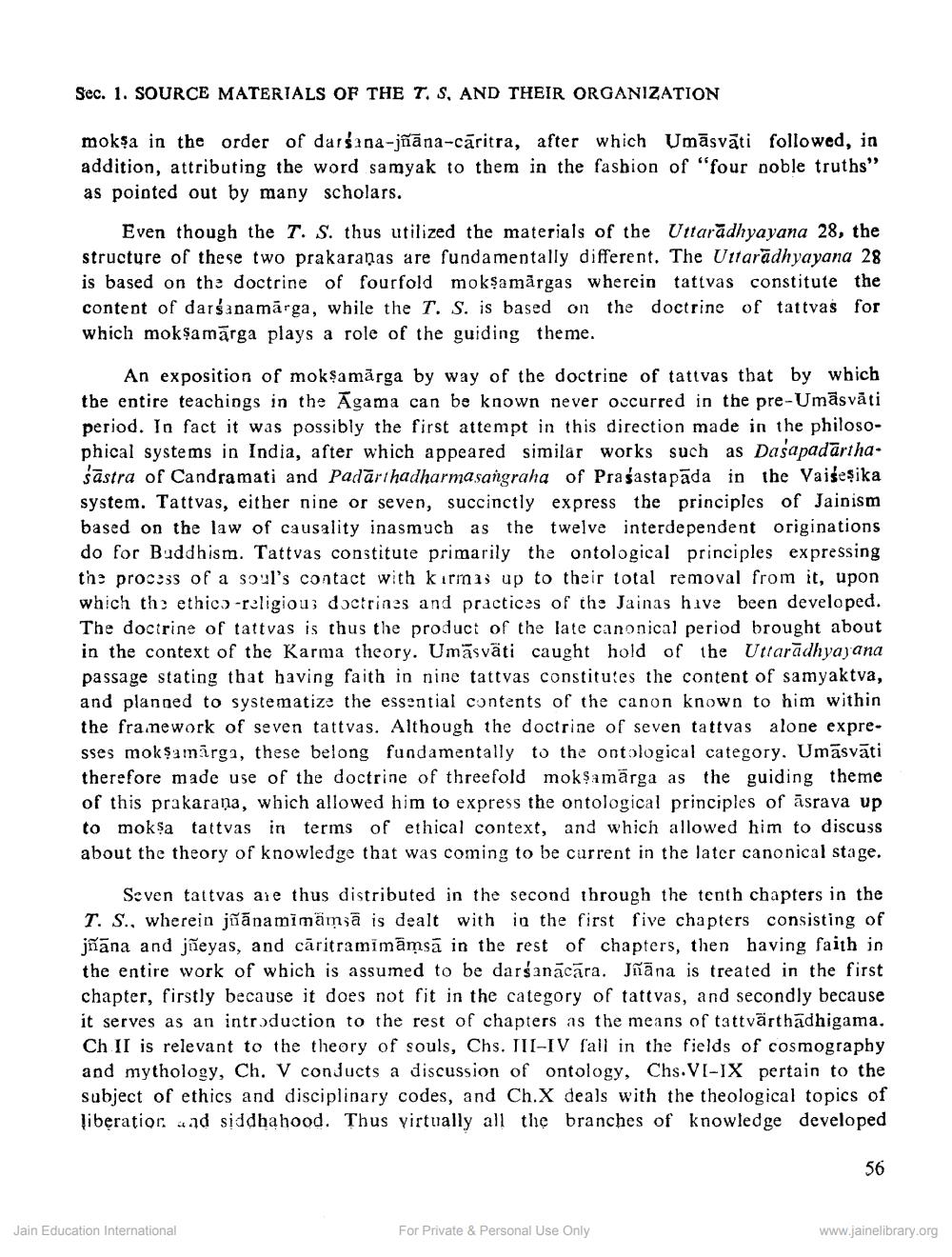________________
Sec. 1. SOURCE MATERIALS OF THE T. S, AND THEIR ORGANIZATION
moksa in the order of darsana-jñāna-caritra, after which Umāsvāti followed, in addition, attributing the word samyak to them in the fashion of "four noble truths" as poioted out by many scholars.
Even though the T. S. thus utilized the materials of the Uttarādhyayana 28, the structure of these two prakaranas are fundamentally different. The Uttarādhyayana 28 is based on the doctrine of fourfold mokşamärgas wherein tattvas constitute the content of darśanamärga, while the T. S. is based on the doctrine of tattvas for which mokşamārga plays a role of the guiding theme.
An exposition of mokşamărga by way of the doctrine of tattvas that by which the entire teachings in the Agama can be known never occurred in the pre-Umāsvāti period. In fact it was possibly the first attempt in this direction made in the philosophical systems in India, after which appeared similar works such as Dasapadārtha. Sastra of Candramati and Padārihadharma sangraha of Prasastapāda in the Vaišeşika system. Tattvas, either nine or seven, succinctly express the principles of Jainism based on the law of causality inasmuch as the twelve interdependent originations do for Buddhism. Tattvas constitute primarily the ontological principles expressing the process of a soul's contact with kirmis up to their total removal from it, upon which th: ethico-religious doctrines and practices of the Jainas have been developed. The doctrine of tattvas is thus the product of the late canonical period brought about in the context of the Karma theory. Umāsväti caught hold of the Uttarādhyayana passage stating that having faith in nine tattvas constitutes the content of samyaktva, and planned to systematize the essential contents of the canon known to him within the framework of seven tattvas. Although the doctrine of seven tattvas alone expresses mokşamärga, these belong fundamentally to the ontological category. Umāsvāti therefore made use of the doctrine of threefold mokşamärga as the guiding theme of this prakarana, which allowed him to express the ontological principles of asrava up to moksa tattvas in terms of ethical context, and which allowed him to discuss about the theory of knowledge that was coming to be current in the later canonical stage.
Seven tattvas are thus distributed in the second through the tenth chapters in the T. S., wherein jñānamimämā is dealt with in the first five chapters consisting of jñāna and jñeyas, and cāritramimāmsā in the rest of chapters, then having faith in the entire work of which is assumed to be darsanācāra. Jñāna is treated in the first chapter, firstly because it does not fit in the category of tattvas, and secondly because it serves as an introduction to the rest of chapters as the means of tattvärthadhigama. Ch II is relevant to the theory of souls, Chs. III-IV fall in the fields of cosmography and mythology, Ch. V conducts a discussion of ontology, Chs.VI-IX pertain to the subject of ethics and disciplinary codes, and Ch.X deals with the theological topics of liberation and siddhahood. Thus virtually all the branches of knowledge developed
56
Jain Education International
For Private & Personal Use Only
www.jainelibrary.org




